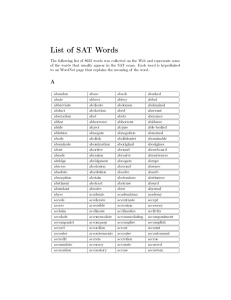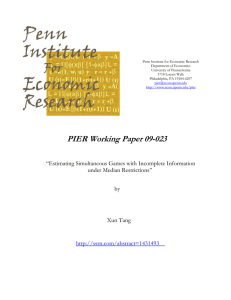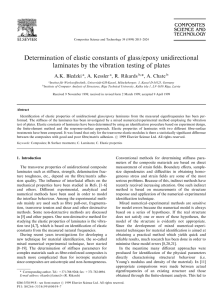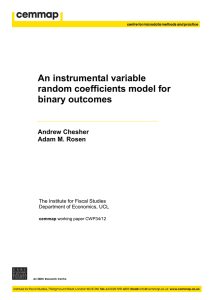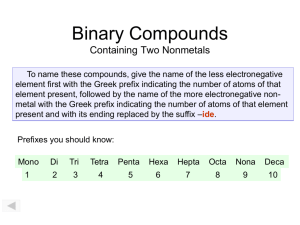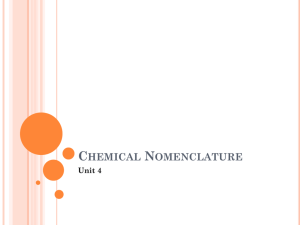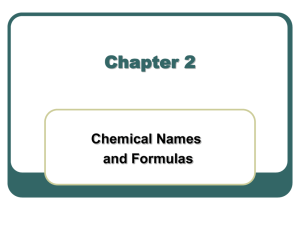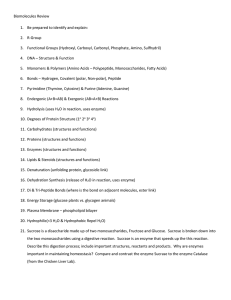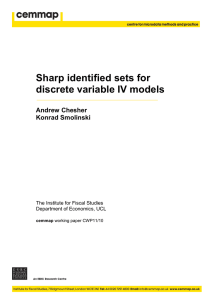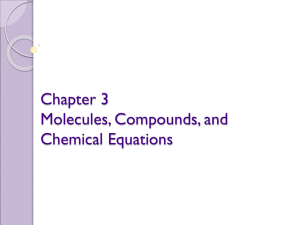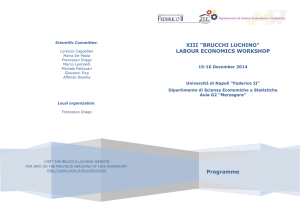Identi…cation Analysis and Evidence Science Andrew Chesher
advertisement
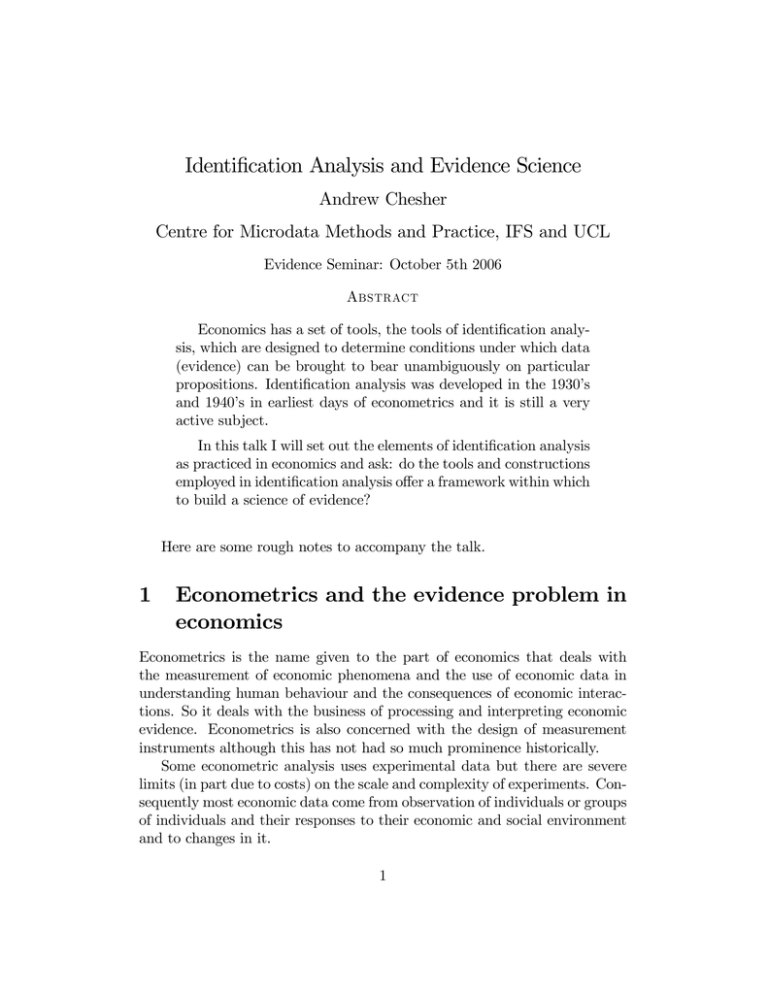
Identi…cation Analysis and Evidence Science Andrew Chesher Centre for Microdata Methods and Practice, IFS and UCL Evidence Seminar: October 5th 2006 Abstract Economics has a set of tools, the tools of identi…cation analysis, which are designed to determine conditions under which data (evidence) can be brought to bear unambiguously on particular propositions. Identi…cation analysis was developed in the 1930’s and 1940’s in earliest days of econometrics and it is still a very active subject. In this talk I will set out the elements of identi…cation analysis as practiced in economics and ask: do the tools and constructions employed in identi…cation analysis o¤er a framework within which to build a science of evidence? Here are some rough notes to accompany the talk. 1 Econometrics and the evidence problem in economics Econometrics is the name given to the part of economics that deals with the measurement of economic phenomena and the use of economic data in understanding human behaviour and the consequences of economic interactions. So it deals with the business of processing and interpreting economic evidence. Econometrics is also concerned with the design of measurement instruments although this has not had so much prominence historically. Some econometric analysis uses experimental data but there are severe limits (in part due to costs) on the scale and complexity of experiments. Consequently most economic data come from observation of individuals or groups of individuals and their responses to their economic and social environment and to changes in it. 1 Many aspects of individuals and their environment go unmeasured or are imperfectly measured. Individuals and organisations are instrumental in determining their own situation and, possibly imperfectly, optimise their responses. When they do this their relative valuations of current and future, certain and risky, outcomes are in‡uential as are their views of the likelihood of future outcomes and their knowledge of their current situation. All of these elements vary across individuals and perhaps over time. With many aspect of individuals preferences and environment unmeasured there is much scope for ambiguity in the interpretation of the limited record provided in economic data. A very early concern in econometrics was the problem of determining the conditions under which economic data are capable of particular interpretations. This is the subject studied under the heading “identi…cation”. It is distinct from, and logically prior to, the problem of inference. 2 Examples of identi…cation problems Here are some examples problems where identi…cation issues arise. 2.1 Demand supply and market equilibrium Desired demand for (e.g.) ‡owers (e.g. by households at some location) is a decreasing function of the price at which ‡owers are sold and demand side factors (e.g. income, timing of religious festivals). Desired supply of ‡owers (by sellers at some location) is an increasing function of the price at which ‡owers are sold and supply side factors (e.g. weather conditions, transport costs). Buyers and sellers come together in a market and the price at which transactions occur is the price at which desired demand and supply are equal. This process continues day after day and data record for each day the price at which ‡owers are bought and sold, the amount bought and sold and demand and supply side factors. Under what circumstances can the data reveal information about either demand functions or supply functions or both? 2 2.2 Returns to schooling People choose investments in schooling which depend on ability and family factors. They later earn wages that depend on their schooling outcomes and ability. We see data on schooling outcomes, wages and family factors for a sample of people, but there is no record of ability. Under what conditions can this data reveal information about the “pure”(ceteris paribus) e¤ect of schooling on wages, ability held constant? 2.3 Smoking and mortality People have di¤erent life expectations and smoking causes diseases which rarely a¤ect the young. Perhaps people with the view that there life expectation is relatively short are over-represented amongst smokers. Can data on smoking behaviour and mortality alone reveal the e¤ect of smoking on mortality? What additional measurements could resolve this problem and under what conditions? 2.4 Assessing the bene…t of training programmes Aimed at the long term unemployed, training programmes are designed to speed return to work and promote longer job tenure. Those who view programmes as well suited to their needs may be more inclined to join and remain in training programmes. Under what conditions can data on participation in programmes and subsequent labour market histories be informative about the e¢ cacy of training programmes? 2.5 Identi…cation and evidence Thinking of data, or functions of data, as “evidence” it seems at …rst sight as if identi…cation analysis as practiced in econometrics may have relevance for evidence science. But is that the case? I will return to this question. First I will try to set out the bare bones of identi…cation analysis. Even if there is nothing here for evidence science it may be interesting to see how this problem is approached in economics. 3 3 Identi…cation analysis 3.1 Measurement and random variation We imagine a process generating data on a list of outcomes Y under circumstances characterised by a list of unobservable variables U and observable variables X. From time to time and/or from person to person X and U vary and as a result Y varies. Values of Y and X (but not U ) are recorded. The various variables are taken to be measurable and are regarded as random variables with well de…ned probability distributions.1 Data are regarded as realisations of these random variables, drawn from these probability distributions. Variables could be binary indicating possession (or not) of some characteristic or occurrence or otherwise of some event, so measurability is not perhaps as severe a restriction as it might seem at …rst sight. Data are informative about the joint distribution FY X but in some cases one works entirely with the conditional distribution FY jX allowing that X may not be a random variable at all. For data to be informative about probability distributions there has to be a sense in which information accrues as data are amassed. 3.2 Processes Given a value of X and U , a value of Y is generated as a unique solution to an equation g(Y; X; U ) = 0: Formally g is a vector valued function. In the wage (Y1 ), schooling (Y2 ) example g could have the form Y1 = Y2 = Y2 + U1 + U2 X + U2 where U2 denotes ability. Uniqueness of the solution for Y is important. The probability distribution of X and U together with a function g that solves uniquely for Y induce a probability distribution for Y and X. A particular process is called a structure. A structure S consists of a particular function g S and a particular probability distribution of U and 1 We may make an exception for X. 4 X, FUSX : S = fg S ; FUSX g. Each structure S implies exactly one probability distribution FYSX . If one is working conditionally on X then there will be S = fg S ; FUSjX g which implies exactly one conditional probability distribution FYSjX . 3.3 Observational equivalence When appraising evidence we are interested in the particular structure S generating the data (evidence) before us. This data is informative about the probability distribution FYSX associated with S . In identi…cation analysis one asks: under what conditions is knowledge of the probability distribution implied by the structure informative about the structure or features of it. The question arises because, although for each S there is exactly one FYSX , there may be many structures S which imply a particular FY X , that is there may be S1 6= S2 such that FYS1X = FYS2X . Structures S1 and S2 such that S1 6= S2 and FYS1X = FYS2X are said to be observationally equivalent (OE). If two structures are observationally equivalent then no amount of data can be informative about the identity of the structure which generated the data. If there are propositions which are true in one structure and false in another and both structures are observationally equivalent then the proposition can never be con…rmed or denied on the basis of evidence contained in data. 3.4 Models Models are restrictions that de…ne which structures are admissible, that is could have generated data. For example the restrictions: g is linear in its arguments and U and X are independently distributed random variables is a model. With Y = (Y1 ; Y2 ) and X = (X1 ; X2 ) and U = (U1 ; U2 ) and with Greek symbols denoting constants this model could be expressed as follows. (A). Y1 = (B). Y2 = 12 Y2 + 21 Y1 + 11 X1 + 21 X1 + 12 X2 + U1 22 X2 + U2 (C). (U1 ; U2 ) and (X1 ; X2 ) are independently distributed Models de…ne sets of structures. 5 Consider a model M and a structure S0 2 M . If there is no S1 2 M (with S1 6= S0 ) such that FYS1X = FYS0X then M identi…es S0 . If M identi…es all structures S 2 M then M is a uniformly identifying model. There is a one-to-one correspondence between the structures admitted by a uniformly identifying model and the probability distributions they imply. If we add the restrictions f 12 = 21 = 0; 11 6= 0; 22 6= 0g to the model set out above then the model is uniformly identifying if X1 and X2 vary su¢ ciently. The restrictions f 12 = 21 = 0g also render the model uniformly identifying. Current econometric research on identi…cation studies models in which there are not parametric restrictions. 3.5 Restrictiveness of models and just identifying models If M1 M0 then M0 admits structures which are not admitted by M1 and M1 is more restrictive than M0 . If M0 is a uniformly identifying model and M1 M0 then M1 is also a uniformly identifying model. Suppose M0 is a uniformly identifying model and that no model M with M0 M is uniformly identifying. Then M0 is said to be a just identifying model. A just identifying model loses its (uniform) identifying power if any of its restrictions are relaxed. 3.6 Falsi…ability of models If every structure not admitted by a model is observationally equivalent to some structure admitted by the model then the model cannot be falsi…ed. A model M is falsi…able if there exists a structure not admitted by the model which is observationally distinguishable from every structure admitted by the model, that is if there exists S 2 = M such that for every S 2 M , FYSX 6= FYSX . All non-falsi…able models are just identifying. There exist just identifying models that are falsi…able. 3.7 Features of structures Often there is interest only in some feature of a model, for example a coe¢ cient in a linear equation system, or the sign of such a coe¢ cient (e.g. 12 ) above. A model may identify a structural feature when it is not uniformly 6 identifying. This happens when, even though a model admits observationally equivalent structures, a feature is invariant within any set of observationally equivalent structures. Formally let (S) be a feature of structure S, consider a model M and a structure S0 2 M . A model M identi…es (S0 ) if (S0 ) = (S) for every S in M which is observationally equivalent to S0 . If this is true for every S0 2 M then the model uniformly identi…es . If a model M0 identi…es a structural feature and M1 M0 then the more restrictive model M1 also identi…es the structural feature. Suppose that M1 identi…es a structural feature and that there is no M0 with M1 M0 such that M0 identi…es the structural feature. Then M1 is a just identifying model for that structural feature. There may be many just identifying models for a structural feature. One can sometimes obtain a just identifying model M1 from another just identifying model M0 by relaxing one restriction of M0 while tightening another restriction. If M0 and M1 are both just identifying models for a structural feature then M0 * M1 and M1 * M0 . 3.8 Set identi…cation The discussion so far has been about point identi…cation. Consider a structural feature and a model and suppose that within any set of observationally equivalent structures admitted by the model the structural feature lies in a set. In this case the model set identi…es the structural feature. Set identi…cation and inference on set identi…ed structural features is an active research …eld in econometrics. There is an example in Chesher (2005a). 3.9 3.9.1 How can the identifying power of a model be determined? Identi…cation of structures The power of a model for identifying structures is shown by demonstrating that no two structures admitted by the model generate the same distribution of Y and X (or of Y given X if the analysis is conditional on X). This can be easy to do when a model is parametrically speci…ed. An example is provided by the model below if augmented by the restriction that all variables are jointly normally distributed. 7 3.9.2 Identi…cation of features of structures It can be proved2 that if, for a model M , there exists a functional of the distribution function of Y and X, G(FY X ), such that for all S 2 M , when (S) = a, G(FY X ) = a, then M identi…es . Here is an example of this in action. There is the model: (A). Y = X + U (B). For z 2 Z, E[U jZ = z] = c, E[XjZ = z] exists, is …nite and varies with z in which note there is no requirement that X and U be uncorrelated or independent. For (z1 ; z2 ) 2 Z there is: E[Y jZ = z1 ] = E[XjZ = z1 ] + c E[Y jZ = z2 ] = E[XjZ = z2 ] + c and so if E[XjZ = z1 ] 6= E[XjZ = z2 ]: = E[Y jZ = z1 ] E[XjZ = z1 ] E[Y jZ = z2 ] : E[XjZ = z2 ] Consider some value a. Every structure with Y , X and Z such that E[Y jZ = z1 ] E[XjZ = z1 ] = a implies a distribution for E[Y jZ = z2 ] =a E[XjZ = z2 ] the left hand side expression here being the required functional G. 4 Identi…cation and Evidence Science A few incomplete remarks. 1. Considerations of identi…cation arise before considerations of inference (in the statistical sense). When studying identi…cation one asks whether information about propositions could ever be gleaned from any amount of data no matter how large. 2 Chesher (2006). 8 2. Identi…cation is achieved by imposing restrictions. Some restrictions may be based on evidence (got from earlier observation of a process) and others are necessarily beliefs and cannot be falsi…ed. 3. Identi…cation can be achieved by changing the nature of measurement - e.g. measuring more accurately, or measuring di¤erent aspects of a process. 4. In a “structure” one has a complete speci…cation of the way in which observable outcomes are generated. Typically one is interested in some feature of a structure. 5. If observationally equivalent structures are permitted then there is the possibility of alternative explanations of phenomena. Features of structures can be identi…ed when structures themselves cannot. One requires that across observationally equivalent structures the value of the feature of interest does not vary (much). 6. To use this apparatus one must be prepared (able) to think in terms of processes that generate outcomes that are (can be modelled as) realisations of random variables. References Below (1-4) are some of the papers on identi…cation produced during the Evidence project and then a few of the classical references Reference (2) has a more extensive bibliography. (1). Chesher, Andrew (2006): “Instrumental Values,” forthcoming in Journal of Econometrics, revision of Centre for Microdata Methods and Practice Working Paper CWP 17/02. (2). Chesher, Andrew (2003): “Identi…cation in Nonseparable Models,” Econometrica, 71, 1405-1441. (3). Chesher, Andrew (2005a): “Nonparametric identi…cation under discrete variation,”Econometrica, 73, 1525-1550. (4). Chesher, Andrew (2005b): “Identi…cation with Excess Heterogeneity,”Centre for Microdata Methods and Practice Working Paper CWP 19/05, presented at the 2006 European Meeting of the Econometric Society, Vienna. 9 (5). Fisher, Franklin M. (1959): “Generalization of the rank and order conditions for identi…ability,”Econometrica, 27, 431-447. (6). Fisher, Franklin M. (1961): “Identi…ability criteria in nonlinear systems,”Econometrica, 29, 574-590. (7). Fisher, Franklin M. (1966): The identi…cation problem in econometrics, New York: McGraw Hill. (8). Haavelmo, Trygve, M. (1944): “The probability approach in econometrics,”Econometrica, 12, Supplement, July 1944, 118 pp. (9). Hurwicz, Leonid (1950): “Generalization of the concept of identi…cation,”in Statistical inference in dynamic economic models. Cowles Commission Monograph 10, New York, John Wiley. (10). Koopmans, Tjalling C., and Olav Reiersøl (1950): “The identi…cation of structural characteristics,”Annals of Mathematical Statistics, 21, 165-181. (11). Koopmans, Tjalling C., Herman Rubin and Roy B. Leipnik (1950): “Measuring the equation systems of dynamic economics,”in Statistical inference in dynamic economic models. Cowles Commission Monograph 10, New York, John Wiley. (12). Rothenberg, Thomas J. (1971): “Identi…cation in parametric models,”Econometrica, 39, 577-591. 10
